Chapter 20: Legal and Regulatory – Where It Was, Where It Is and What’s Ahead?
Student Learning Objectives:
This chapter presents students with an updated set of considerations relating to the history, methods and objectives of regulating Unmanned Aerial Systems (UAS). Since the first edition of this textbook, the impact of legal and regulatory effect upon the industry has predictably increased both domestically and globally. In this chapter students will examine the regulatory history of UAS as well as those laws and rules presently under consideration and those which may be enacted in the future. Students will also examine the impact which new laws and regulations will have upon new technologies and delicate balance between too little regulation and too much. Finally, students be challenged to decide whether or not they would choose to enact regulations based upon events which may occur in the future and the considerations underlying those decisions.
Introduction
Since the first edition of UNMANNED AIRCRAFT SYSTEMS (UAS) IN THE CYBER DOMAIN: PROTECTING USA’S ADVANCED AIR ASSETS there have been numerous laws, regulations and enactments relating to the operation, identification and responsibilities of UAS in airspace globally. In order for today’s student to understand the complexity and consequences of regulating UAS it is necessary to examine how we have arrived at this point and what were the underlying causative events that led to their enactment. Armed with this information students will be better equipped to navigate the complexities of the interaction between law and technology and the delicate balance between public safety, national defense and the inevitable development of new and more complex automated systems.
As a parallel consideration students should be cognizant that they will be entering an industry where UAS operation, regulatory, insurance, legal and other related industries is expected to grow exponentially in decade. According to a 2018 report by the consultancy firm PricewaterhouseCoopers, by 2030 it is estimated that the Drone/UAS industry will provide a 42 Billion Pound (53 Billion US Dollars) increase in the Gross domestic Product of the United Kingdom alone.[See Figure 20-1.]
Figure 20-1: UK Predicted Uplift in GDP by 2030
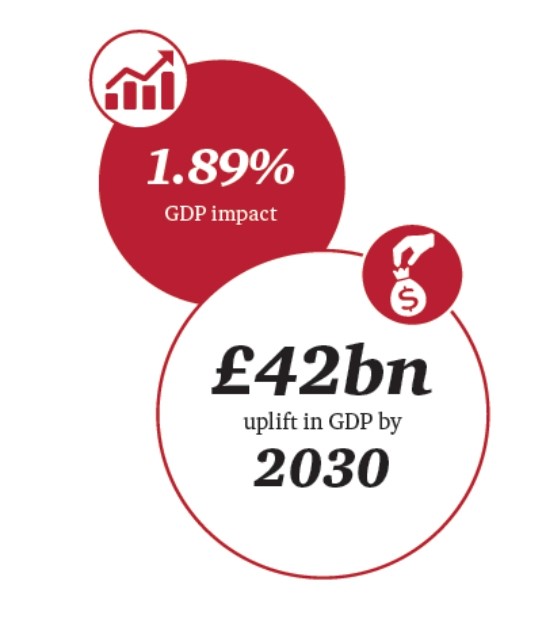
Source: (Pricewaterhousecoopers, LLP, 2018)
Where vast amounts of money flow it is a certainty that disputes will occur, risks need to be insured and legal responsibility will need to be established and adjudicated. Lawyers, Judges, Politicians, Manufacturers, Regulators, are but a few of the many areas of potential growth which will provide vast opportunity for those who choose a career in the UAS legal field. (Ricker, 2017) And for those who choose to follow a career path in other areas, not related to law and regulation, it will still be important for them to have a solid foundation in understanding the interface between UAS law and regulation with the rest of the overall UAS industry.
Current Regulatory Overview
As a preliminary matter the focus of this chapter will be focused upon the legal and regulatory structure of the UAS industry in the United States. This is not done out of any preference or bias but rather recognition that the number of separate regulations continues to grow rapidly with laws being enacted on local, state, federal and international levels. Since it would be impossible to study and digest UAS laws in each nation on earth this chapter will focus upon the broad conceptual considerations of regulatory frameworks as opposed to detailed examination of each and every separate regulation. While the FAA has exclusive authority over the use of airspace in the United States, as of September 2018, 44 states have adopted some sort of UAS regulation. (Sovereignty and use of airspace, 1994) Simultaneously the Federal Aviation Administration and other parts of the federal government continue to promulgate rules and regulations which collectively make the legal landscape quite difficult to navigate and even harder to predict. (National Conference of State Legislatures, 2018) Just as was discussed in the first edition of this text UAS are inherently mobile technology so that they are being used both within, across and beyond local, state and international borders not to mention their use over international waters and unaffiliated or neutral territories. The following figures demonstrate the overlapping web like structure of laws which currently confront those in the UAS industry. [See Figure 20-2]
Figure 20-2: Domestic UAS Regulatory Matrix
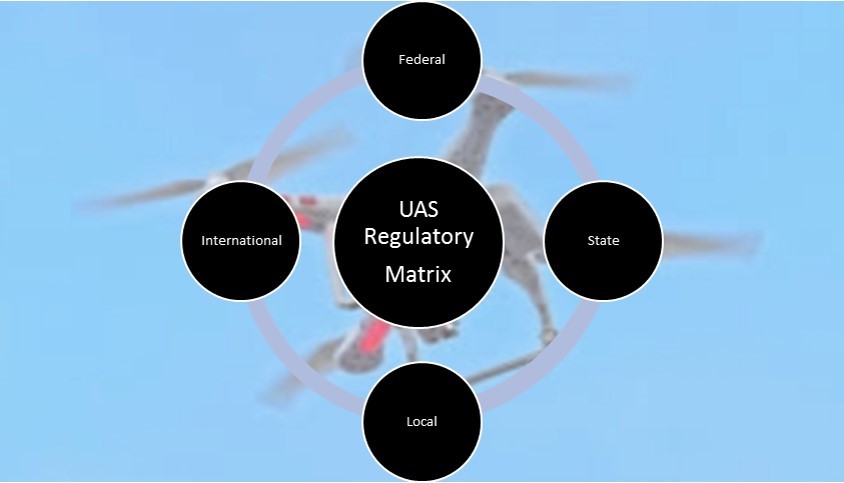
Source: (Sovereignty and use of airspace, 1994)
From a global perspective, as of January, 2018, according to medium.com of 233 countries being tracked just over one half have enacted some form of UAS regulation on a nationwide basis while over 100 nations having yet to have imposed any. (Schroeder, 2018) Most nations also have, states, provinces, prefects or other subdivisions not to mention agencies, authorities and even NGO’s which all can promulgate more regulation. The reality is same globally as it is within the United States, an overlapping web of laws and regulations with a high likelihood that some portions of each may conflict with provisions of others. While the problem is currently one that is more burdensome and confusing than stifling innovation or a direct concern for public safety, with the increased of autonomous transportation the risk of more serious consequences grows with each new enactment.
Figure 20-3: Radiant Earth 2018 Drone Regulation Statistics
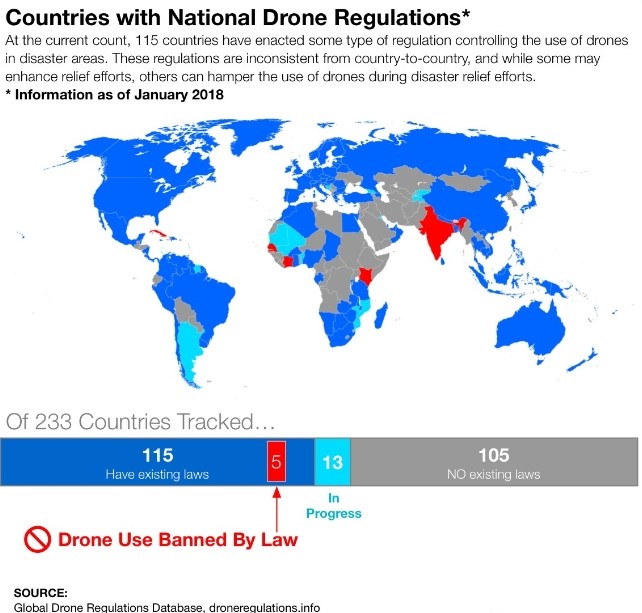
Source: (Database, 2018)
Some may ask “why not have a global set of rules for all nations regarding the UAS industry?” In reality as likely as conflict of regulations is, it is even more likely to expect that each nation’s particular self-interest, autonomy, culture, mores and even form of government make such omnibus regulation a remote prospect at best. Just consider how regulations of UAS in China or North Korea might differ from those in the United States, United Kingdom and Australia. For example, a recreational UAV pilot might feel free to operate a drone over Times Square, Piccadilly Circus or the Sydney Opera House with some degree of registration and identification[1]. Contrast those locations with Tiananmen Square in China or Kim Il-sung Square in Pyongyang, North Korea. How would the CPRC or DPRK security forces react to such a flyover by a hobbyist? Hence the need to be extremely sensitive when regulating UAS to local customs, politics, mores and governing style.
Future Regulatory Framework
In order to achieve the most homogenous global UAS regulatory framework sense to focusing upon certain standardized critical areas which are generally considered “must have” in terms of UAS/UAV legislation seems to be most practical. Those general categories of regulation would consist of the following:
- UAS Pilot Licensing
- Aircraft Registration with Oversight Agency (ies)
- Areas of Restriction, Limited Use of Outright Prohibition
- Liability, Operational “Rules of the road” and penalties for violation. (Jones, 2017), (Muspratt, 2018)
In the United States the regulatory hierarchy is established on a pyramid model where the generalized power to regulate flows from the Congress who then empowers, by legislation the authority to certain government agencies to enact and adopt rules and regulations.
Next, based upon consultation with governmental experts as well as private sector or NGO input, which is vital to ensure that the imposition of regulations does not unduly burden the industry, public or stifle the safe development of the nascent technology. Figure 20-4 depicts just a portion of the hierarchy involved in the legislative and regulatory process in the United States.[2]
A similar regulatory hierarchy exists in each of the fifty states as well as territories, commonwealths and protectorates. While a number of jurisdictions have enacted various legal framework for UAS, still many more are actively considering and debating the imposition of operational, licensure, geographic, insurance, liability and criminal laws and regulations. Not only are such regulations often viewed as a public safety function, it also appears that with each registration, license and permit states can help offset budgetary deficits and create new job opportunities for state workers to administer these type of ministerial requirements. Just look to the study in the first edition of this text of how the automobile led to an entire massive industry in the early 1900’s to where trillions of dollars are currently in play. (Nichols, 2018)
Figure 20-4: Portion of the hierarchy involved in the legislative and regulatory process in the United States
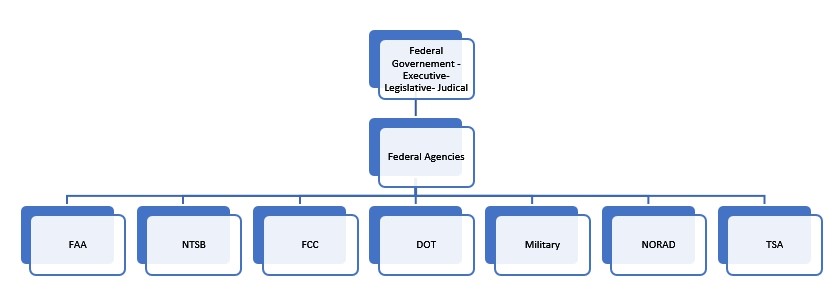
Source: (Lonstein, 2019)
Table 20-1 below is an example of the breadth and effect of many state drone laws.
Table 20-1: North Carolina Regulatory Framework
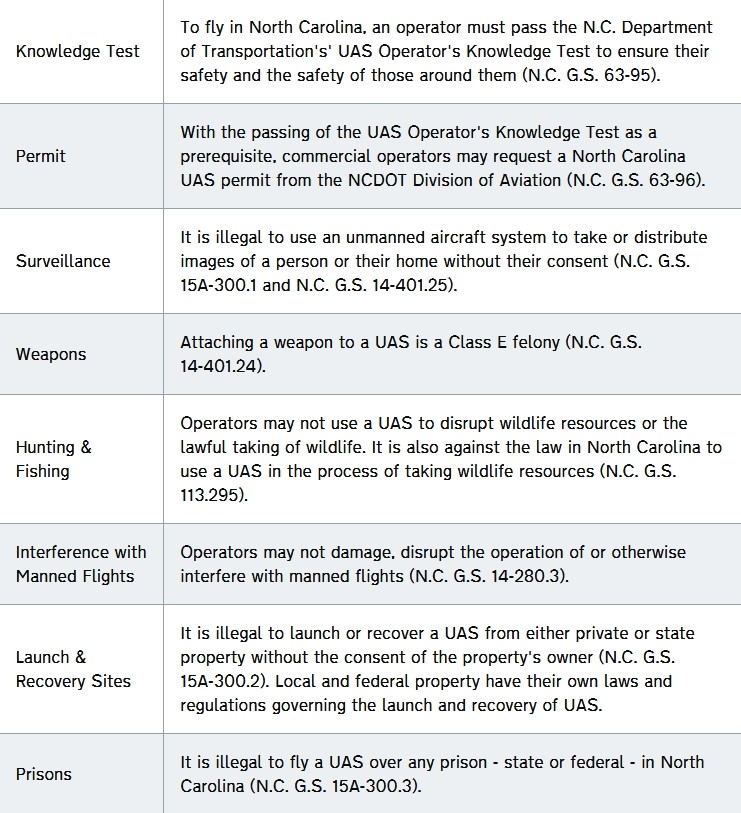
Source: North Carolina Department of Transportation
The North Carolina Regulatory Framework touches many areas of life and law. From hunting and fishing to privacy rights to licensing of pilots. It also contains provisions that are criminal in nature, others civil law and still others ministerial such as the licensure and registration requirement. Students should be aware that common or “case” law will provide interpretation of laws of which UAS professionals must keep abreast.
Below the state level comes local and regional authorities and governments which all can exercise various regulatory powers within their particular jurisdiction.
Finally input from industry associations, trade groups, manufacturers, NGO’s and other private organizations which can all impact in in many ways regulate the UAS/UAV industry in the United States. The interaction between the UAS industry, commercial and private operators and the current and future regulatory structure should not be underestimated. Last is the overarching impact which the military and national defense establishment has upon the UAS industry. Students must be aware that military and national defense jurisdiction is largely border to border and beyond and in many instances trumps civilian authorities.
Figure 20-5: Principles for Future Regulation
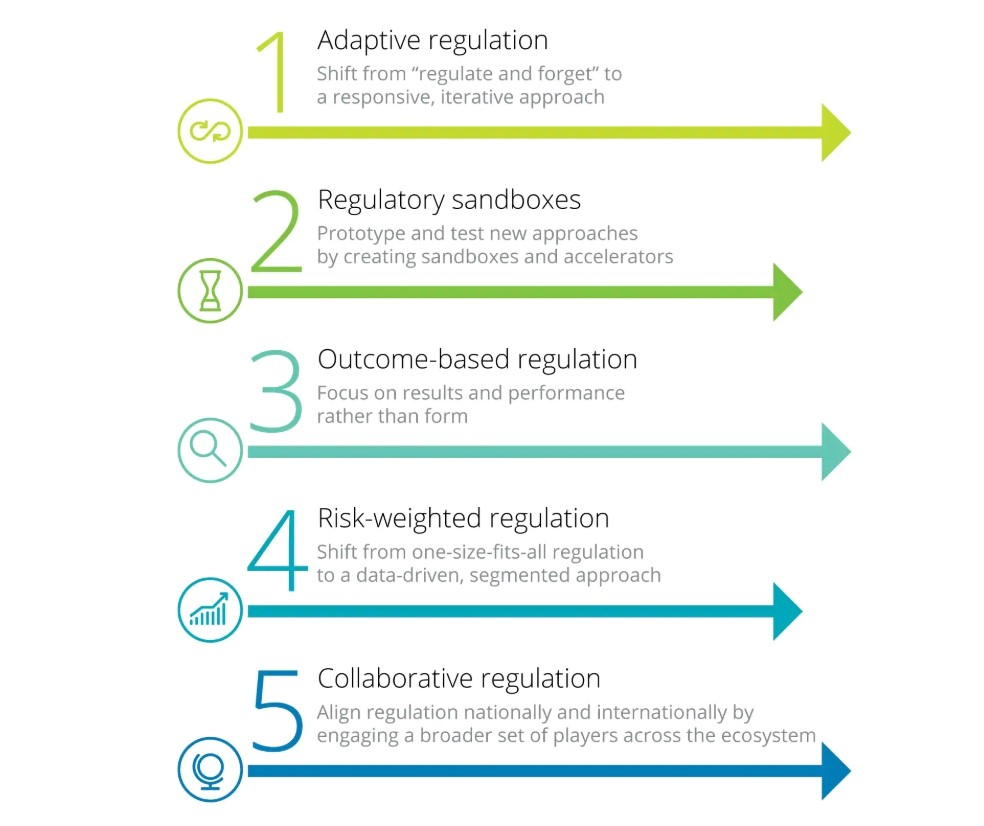
Source: www.airspacemag.com
What is clear that a certain amount of regulation will always be needed however too much of a good thing can be worse than nothing at all. Regulators must be deliberative before, cautious during and responsive after regulation if we are to minimize negative and maximize the positives in UAS and AI regulation. Figure 20-5 is a good example of an agile regulatory framework and roadmap as it aims to find a broad consensus while recognizing the likelihood of unintended consequences. If we are to achieve maximum regulatory efficacy, while minimizing the risk of unintended consequence it will be essential to move quickly when such issues arise. This is particularly important in such a highly technological area where new developments will always outpace the law.
When students encounter the challenges of regulation and jurisprudence of technology, they may be wise to remember the writings of John L. O’Sullivan 1n 1847 who wrote:
Government should have as little as possible to do with the general business and interests of the people. If it once undertakes these functions as its rightful province of action, it is impossible to say to it ‘thus far shalt thou go, and no farther.’ It will be impossible to confine it to the public interests of the commonwealth. It will be perpetually tampering with private interests and sending forth seeds of corruption which will result in the demoralization of the society. (O’Sullivan, 1845)[3]
Conflict of Laws
With so many laws and regulations being promulgated internationally, domestically and locally it is inevitable that some of them will come into conflict with others. For example, North Carolina requires a knowledge test to pilot a done while South Carolina currently has no regulations. (UAV Coach, 2019) When neighboring jurisdictions have different regulations or as in the case of the Carolina’s one state has regulations and the other does not, the prospect of an operator of a UAV encountering a situation of conflict of laws grows. Adding to the likelihood of conflict of laws is the national authority of the FAA over airspace. (49 U.S. Code § 40103, 1994) What are the principles of law that can help resolve these disputes?
Federal supremacy is a constitutionally established doctrine that establishes the supremacy of Federal Law over conflicting state or local laws. It was a clause specifically included in the original text of the United States Constitution in 1776.
“This Constitution, and the Laws of the United States which shall be made in Pursuance thereof; and all Treaties made, or which shall be made, under the Authority of the United States, shall be the supreme Law of the Land; and the Judges in every State shall be bound thereby, any Thing in the Constitution or Laws of any State to the Contrary notwithstanding.” (United States Constitution Article VI, Sec.2, 1787) (Marbury v. Madison, 1803)
From the Supremacy Clause flows the doctrine of Federal Preemption. In 1819 the United States Supreme Court held in McCullough v. Maryland (McCullogh v. Maryland, 1819) that federal legislation or regulation shall be deemed superior to and controlling over any state or local law. Simply put, “Preemption is a doctrine of American constitutional law under which states and local governments are deprived of their power to act in a given area, whether or not the state or local law, rule or action is in direct conflict with federal law.” (Guardbaum, 1994)
In 2017 the Supremacy Clause and Federal Preemption came directly into play in the UAS industry when a medical doctor/ inventor Michael Singer intended drones to deliver medical supplies and services in the greater Newton Massachusetts area. At or about the same time the City of Newton enacted regulations regarding UAV operation in the jurisdiction. The following provisions were challenged by Dr. Singer in federal court.
- Registration with the city of Newton in addition to the previous requirements established by FAA Regulations under Part 107;
- Prohibition of the operation of pilotless aircraft under 400 feet in altitude;
- Operation over private property: and
- Prohibition of Beyond Line of Sight (BLOS) operation. (Singer v. City of Newton, 2017)
In holding the cities regulation invalid under the Supremacy Clause and doctrine of Federal Preemption the court held in part:
“The Ordinance limits the methods of piloting a drone beyond that which the FAA has already designated, while also reaching into navigable space. See Newton Ordinances § 20–64(c (1) (b). Intervening in the FAA’s careful regulation of aircraft safety cannot stand; thus subsection (c) (1) (b) is preempted.” (Singer v. City of Newton, 2017)
Regulatory legal conflict is not the only concern for UAS operators. Liability and insurance claims resulting from drone activity is likely to become a very significant area of litigation and court decisional law. Figure 20-5 is a photo of a drone which crashed into the Church of Latter-Day Saints in Draper, Utah in July of 2017.
Although the size of the drone was thankfully incapable of causing much damage to the property, the case is illustrative of the very likely prospect of larger UAVs crashing or coming into contact with structures, people or other flying and ground based vehicles. Courts will be hearing many cases and will have to blend the common law concepts such as assault, trespass and property privacy rights with statutes and regulations which may add liability to UAV pilots and/or owners. In fact, many states, cities and town may attempt to enact laws which make drone owners “strictly liable” for any harm caused by UAV activity. Strict liability exists when a defendant is liable for committing an action, regardless of what his/her intent or mental state was when committing the action.
Figure 20-6: UAV Crash into LDS Church
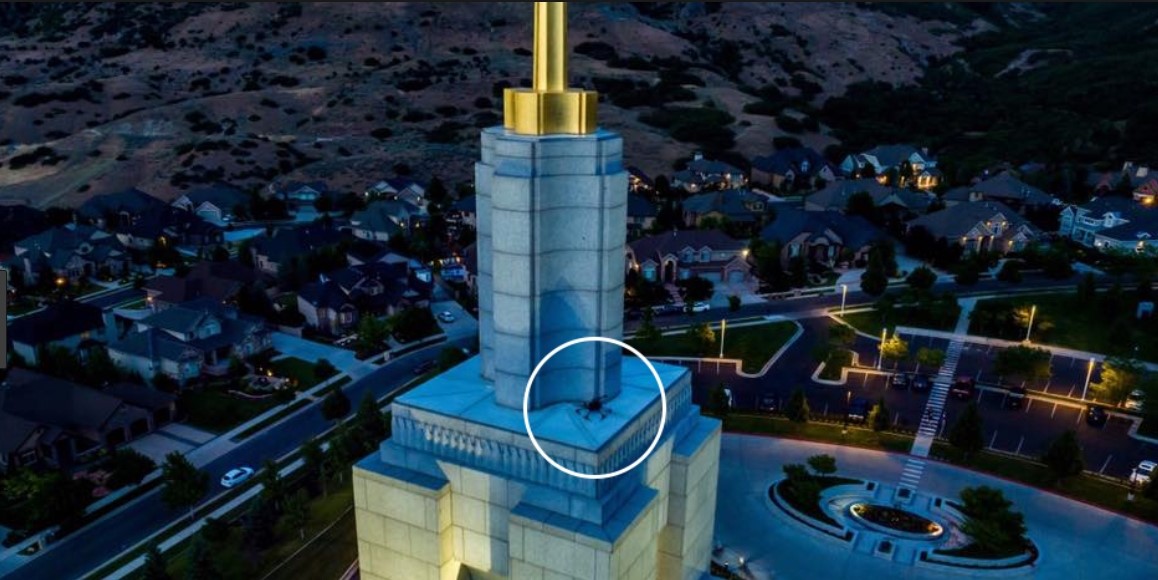
Source: eastidahonews.com
Strict liability legislation is often reserved for harm caused by certain inherently dangerous activity which as a matter of public policy, has been designated as needed heightened liability rules to protect the public. One of the most likely areas of strict liability imposition upon UAS operators is in mid-air collisions where the risks become greater and the potential of damage or death is also greatly increased.
Students should be aware that conflicts of laws and regulation will most certainly increase with the expected exponential growth in commercial and hobbyist use of UAV’s. While they may not directly be involved in the litigation or legislation of UAS rules, they should be keenly aware that there will be many instances where UAS activity may be subject to many laws some of which have conflicting provisions.
A significant portion of Chapter 2 of the First Edition of this text was devoted to the subjects of balancing the need for regulation with the possibility that over-regulation can inhibit the development of this nascent technology and the many benefits that may come from it. While the principles discussed in the prior edition are important for students to understand and assess, the passage of time can help us focus the areas of law where over or conflicting regulations can have real world consequences and inhibit innovation. The Singer decision is most likely just the beginning of an increased friction between the need to regulate and the desire to innovate. (Singer v. City of Newton, 2017)
One area which seems to be especially concerning is the prospect of laws being enacted in other parts of the world which establish liability for those globally. One of the most recent examples of such broad reaching legislation is the European Union’s enactment of the General Data Protection Regulation (GDPR).
The three main objectives of GDPR are:
- This Regulation lays down rules relating to the protection of natural persons with regard to the processing of personal data and rules relating to the free movement of personal data.
- This Regulation protects fundamental rights and freedoms of natural persons and in particular their right to the protection of personal data.
- The free movement of personal data within the Union shall be neither restricted nor prohibited for reasons connected with the protection of natural persons with regard to the processing of personal data. (European Union, 2019)
While on the surface on may ask, how does a data protection law enacted by the European Union have any impact on the UAS industry in the United States or other non-EU nations? As it is said, the devil is in the details.
GDPR defines personal data as:
“Personal data is any information that relates to an identified or identifiable living individual. Different pieces of information, which collected together can lead to the identification of a particular person, also constitute personal data.” (European Union, 2019)
The definition of personal data is quite broad and when combined with the fact that any online form of communication may impact jurisdictional boundaries of the European Union, the potential of GDPR consequence from an online connected activity grows. For example, imagine you are a recreational drone pilot who likes to fly over beautiful homes on the South Florida
Coastline. You stream the flight video using Live4 or other streaming technology and fly by many beautiful homes along the fight.[4]
Along the flight, homes, mailboxes, house numbers, license plates and street sighs are all broadcast live globally. Additionally, there are a significant European citizens who own property in South Florida. Once recorded by the onboard camera and data processed for streaming in theory the UAV owner and/or pilot has in fact committed a GDPR violation.
Figure 20-7: Today Show Residential Drone Privacy
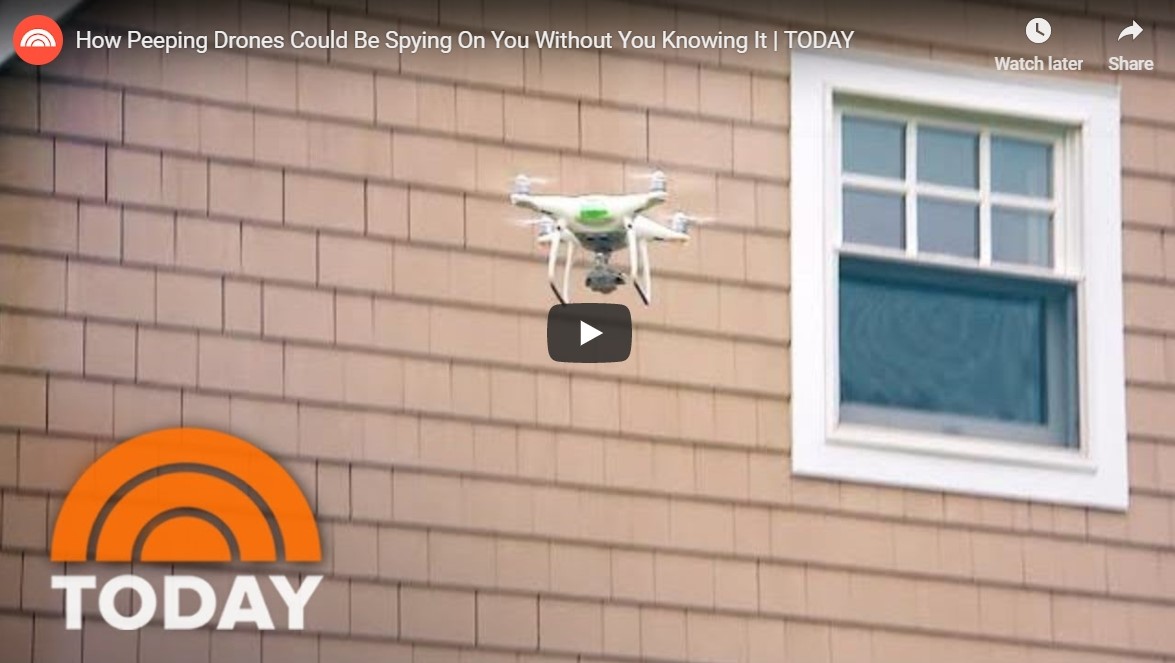
Source: NBC Today Show. (2018, May 9)
In terms of penalties they are significant and can easily cause havoc with commercial drone package delivery system in its infant stages. Although the possibilities of conflicts and confusion increase with each new law or decision, student should try to at least maintain a modicum of familiarity with recent laws, decisions and trends. Though by no means complete, some websites students may wish to visit include https://uavcoach.com/drone-laws/, http://www.ncsl.org/research/transportation/2017-unmanned-aircraft-systems-uas-state-legislation-update.aspx and https://www.americanbar.org/groups/air_space/.
Putting It Together – Where Law Meets Reality
As a general matter from the author’s perspective much of the legal and regulatory process is about prescribing behavior and assessing blame when the laws are violated. In order to adequately operate within any quadrant of the greater UAS industry it is vital that students understand that each and every decision they make can have a legal consequence. To that end when designing aircraft, creating products, developing processes or even drafting regulations, consideration must be given to its legal consequences and the secondary effect upon the greater UAS industry.
Scenario 1
Randy, a drone hobbyist in the Rocky Mountains created local business of selling real-time and recorded video of crimes scenes, fires, and other serious disasters. Over time local television and print media would turn to Randy to acquire drone footage of breaking news in order to enhance their coverage. After a while Randy upgraded his aircraft, cameras and skills, He even formed a corporation called Dragon Vision to being to commercialize and become a true UAV video and photo vendor. Television, realtors, newspapers, even the local police were among many customers who began to regularly pay for his services.
During a particularly dry season the mountains near Randy’s Rocky Mountain home a series of deadly wildfires, caused by a careless hiker with a cigarette butt which was not extinguished before he flicked it into the pine straw. Within moments, fueled by gusty winds the cigarette lit the pine straw and within moments thousands of acres of pristine forest were ablaze, including portions of the Rocky Mountain National Park. Local fire-fighters immediately summoned state and federal resources and simultaneously media bean to flock to the region. Frank was called by media and even the local fire authorities to help them by using his UAV fleet to capture images, provide streaming video and even identify “hot-spots” where new fires were igniting by using an infrared thermal imaging scanners on one of this aircraft.
Figure 20-8: DJI Matrice 210 V2 With Zenmuse XT2 Thermal & Zenmuse Z30 Visual
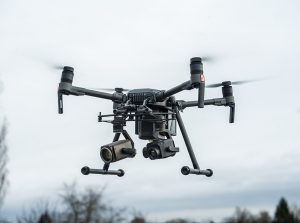
Source: Enterprise DJI.com
Cameras
Randy, ever the Good Samaritan immediately went into action without any agreements with any of the consumers of his content, just the usual handshake. As the fire spread Randy streamed live and also took still photos for the various fire departments and news outlets. As the fire continued to be spread by stronger winds, he found that the drone was increasingly difficult to control because of smoke, heat, uplift wind gusts from the fire and rotor wash from firefighting helicopters.
The result? Firefighting aircraft were unable to drop payloads until the confusion and uncertainty caused by Randy’s drone could be resolved. Unfortunately, the delay let to the fire expanding and either partially or totally was responsible for the loss of thousands of acres of forest and hundreds of homes. Thankfully no humans were seriously injured or killed, and all pets and livestock had been relocated.
What are some of the laws may be implicated in the case of Randy’s UAV misadventure in the Rocky Mountains? Who might be subject to these claims other than Randy?
Implicated Federal Laws
- 49 U.S. Code § 40103. Sovereignty and use of airspace
- FAA Regulation Part 107 Requiring Registration of UAV and Certification of a Commercial Pilot of a UAV, Daylight Only, Under 100 MPH, below 400 feet and in line of sight.
- 43 CFR 9212.1(f), it is illegal to resist or interfere with the efforts of firefighter(s) to extinguish a fire.
- UAS operation prohibited within all National Parks 36 CFR 2.17 (a) (3)
State Statutes
Title 18 – Criminal Code
- 18-8-104. Obstructing a peace officer, firefighter, emergency medical services provider, rescue specialist, or volunteer.
Colorado Misdemeanor & Felony Criminal Trespass – Third Degree Criminal Trespass (18-4-504)
Proposed Colorado Law:
- SECTION 1. In Colorado Revised Statutes, add 18-7-802 as follows:
- 18-7-802. Criminal invasion of privacy by the use of a device – penalty.
Common Law Implications
- “Invasion of Privacy
Unreasonable intrusion upon the seclusion of another
(1) Another person has intentionally intruded, physically or otherwise;
(2) Upon the seclusion or solitude of the plaintiff;
(3) The intrusion would be offensive to a reasonable person; and
(4) The invasion was a cause of plaintiff’s damages. “ (MacGregor, 2018)
General Negligence
(1) “The defendant owed a legal duty to the plaintiff;
(2) The defendant breached that duty; and
(3) The breach resulted in injury to the plaintiff.” (MacGregor, 2018)
Nuisance
(1) “The defendant unreasonably and substantially interfered with;
(2) The plaintiff’s use and enjoyment of his property.” (MacGregor, 2018)
Products Liability -Misrepresentation
(1)” The defendant sold the product while engaged in the business of selling the product for resale, use, or consumption;
(2) The defendant misrepresented a fact concerning the character or quality of the product that would be material to purchasers of the product or members of the public at large;
(3) The plaintiff or a third party purchased the product and reasonably relied on the misrepresentation; and
(4) The plaintiff suffered damages as a result of his or a third party’s reasonable reliance on the misrepresentation. (Porter, 2019)
Products Liability –Misrepresentation
(1) The defendant owed a legal duty of care to the plaintiff;
(2) The defendant breached that duty; and
(3) The defendant’s breach resulted in injuries to the plaintiff.” (MacGregor, 2018)
Products Liability – Strict Liability
(1) “The product is in a defective condition unreasonably dangerous to the user or
(2) consumer or to the consumer’s property;
(3) The seller is in the business of selling such a product;
(4) The design defect caused the plaintiff’s injury; and
(5) The plaintiff incurred damages as a result.” (MacGregor, 2018)
Trespass
(1)” Intentional physical intrusion on the plaintiff’s property;
(2) Without proper permission; and
(3) Legal entitlement to possession of property by the party claiming trespass.” (MacGregor, 2018)
Figure 20-9: No Drone Operation Rocky Mountains
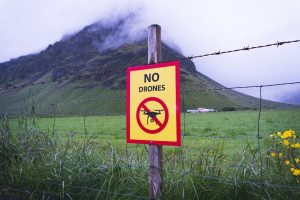
Source: (MacGregor, 2018)
Possibly Liable Parties:
First and foremost, the hiker is would most certainly be deemed to have some degree of criminal or civil liability for being the cause of the fire itself. Had he not flicked a lit cigarette into the dry pine straw reason dictates the fire would never have occurred. This is known as the “But-for test” which asks, “but for the existence of the hiker’s action of flicking a burning cigarette onto pine straw in a dry nation park, would the forest fire have occurred?” If the answer is yes, then factor X is an actual cause of result Y. Other jurisdictions use the similar concept of “proximate cause” which asks whether the defendant’s actions are closely enough related to the result to make the defendant responsible. (Cornell University Legal Information Institute, 2019) Under either test the hiker would likely be found to be proximate or actual cause of the fire.
Randy is the next logical target for possible criminal and civil exposure, not only could he be fined or criminally charged by the FAA if his UAV was not registered, he could also face charges from the National Park Service for operating in a restricted area. He may also be charged with a violation of the federal law prohibiting UAV interference with firefighters. Similarly, the Colorado laws against obstructing a firefighter, criminal trespass and criminal invasion of privacy may also cause criminal liability on a state level. His potential liability stems from the legal concept of intervening or contributory cause. In this case whatever Randy did occurred after and as a result of the Hiker causing the fire. His liability will be predicated upon the concept of intervening or contributory cause. Intervening cause is defined as an event that occurs after a party’s improper or dangerous action and before the damage that could otherwise have been caused by the dangerous act, thereby breaking the chain of causation between the original act and the harm to the injured person. The result is that the person who started the chain of events may no longer be considered fully or partially responsible for damages to the injured person since the original action is no longer the proximate cause. (Cornell University Legal Information Institute, 2019)
What other parties have possible liability to those property owners and the National Park Service itself for damages sustained or exacerbated during the fire? Was there a defect or improper design that led to the inability of Randy to navigate and control the UAV which caused the delay in dispersing fire retardant in some way caused by, DJI, Zenmuse or their component suppliers?
The prospect of liability on behalf of DJI, Zenmuse or their suppliers will likely flow from the concept of product liability and breach of warranty. This type of liability blends elements of tort or negligence law with principles of contractual law where a product was not designed, manufactured or perform in the manner promised in Figure 20-9.
From a civil liability perspective Randy may be the target of both federal and state litigation. Students must also be aware that there are concurrent and special jurisdictional rules for claims arising on federal property or between citizens of different states. Specifically, at least two different types of subject matter may result in Randy being named as a defendant in a Federal Court action.
Jurisdiction: Subject Matter
The first example of subject matter jurisdiction in federal courts (what this dispute is about – its “subject matter”) is known as Federal Question Jurisdiction. The Federal Question jurisdiction reads: The district courts shall have original jurisdiction of all civil actions arising under the Constitution, laws, or treaties of the United States. (Federal Question, 1948)
Figure 20-10: DJI Public Safety Applications
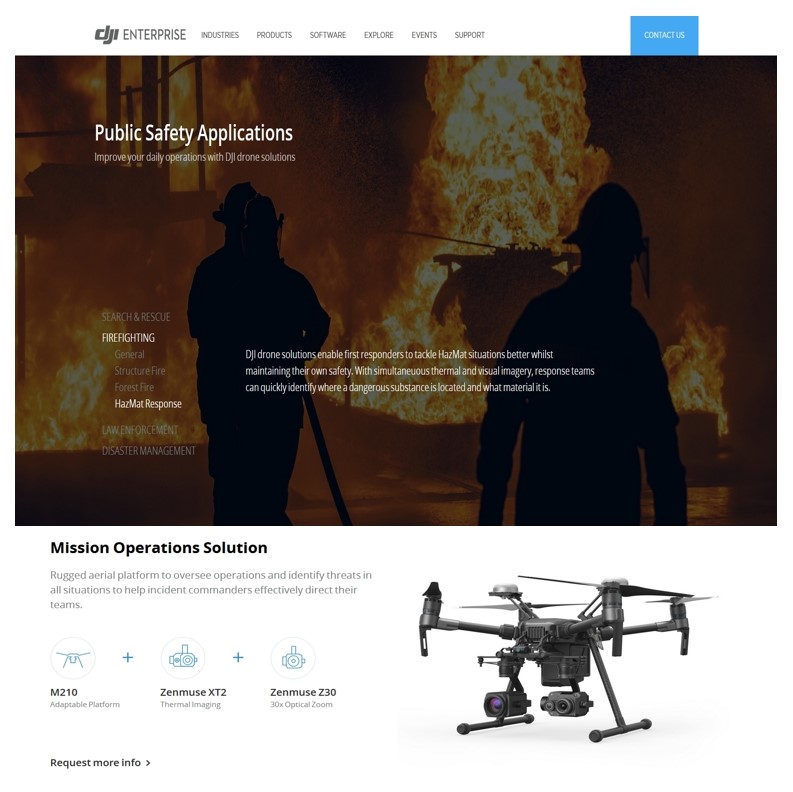
Source: DJI Enterprise. Retrieved from dlsrpros.com
A second type is called diversity jurisdiction. The Diversity Jurisdiction statute reads in applicable part:
(a) The district courts shall have original jurisdiction of all civil actions where the matter in controversy exceeds the sum or value of $75,000, exclusive of interest and costs, and is between—
(1) Citizens of different States;
(2) citizens of a State and citizens or subjects of a foreign state, except that the district courts shall not have original jurisdiction under this subsection of an action between citizens of a State and citizens or subjects of a foreign state who are lawfully admitted for permanent residence in the United States and are domiciled in the same State;
(3) Citizens of different States and in which citizens or subjects of a foreign state are additional parties; and
(4) A foreign state, defined in section 1603(a) of this title, as plaintiff and citizens of a State or of different States. (Diversity of citizenship; amount in controversy; costs, 1948)
When applying these principles to Randy’s drone operation in Colorado and particularly, the consequences caused by it, the Federal and State Courts would have Subject Matter jurisdiction to adjudicate claims as delineated above.
Personal Jurisdiction
Broadly speaking “Personal jurisdiction refers to the power that a court has to make a decision regarding the party being sued in a case. Before a court can exercise power over a party, the U.S. Constitution requires that the party has certain minimum contacts with the forum in which the court sits. International Shoe v Washington, 326 US 310 (1945). So, if the plaintiff sues a defendant, that defendant can object to the suit by arguing that the court does not have personal jurisdiction over the defendant.” (Cornell University Legal Information Institute, 2019)
Practically speaking Personal Jurisdiction asks the following question, is it fair to expect that one’s actions have an effect or consequence in a location which under the notions of fairness and reason would cause an actor to perceive the likelihood of being subject to the jurisdiction of a court in that location? When applied to Randy’s drone activities during the fire it is clear that a reasonable person who was engaging in drone flights during a wildfire in the Rocky Mountain National Park might expect that civil or criminal proceedings resulting from his actions could be instituted in Colorado State or Federal District Courts. [5]
Although it is unrealistic for students to become deeply immersed in UAS jurisprudence, it is essential that students remain cognizant of the interplay between the law and autonomous systems domestically and internationally.
Scenario 2
It is January 2021 and the Inauguration ceremonies are about to begin throughout the greater Washington, DC region. As a result of the 2016 Presidential Election there is still a significant amount of political unrest related to the claim that other nations interfered in some fashion with the electoral process. In an abundance of caution the various military, federal, state and local stakeholders have devised a layered and agile defense strategy. As part of the analysis many experts have expressed concern that the use of UAS in crowded, public “soft targets” has been repeatedly mentioned in terror network chatter intercepted in the months immediately after the November 2020 election. After Inauguration Day concludes without incident, a significant portion of the security infrastructure begins to stand down and for the most part initial debriefing calls the plan a success.
The following weekend is the National Football League NFC Championship Game between the Washington Redskins and San Francisco 49ers at Fedex Field just east of the District of Columbia. During pre-game festivities a concert starring Beyoncé and Jay-Z. In addition to the 82,000-fan standing room only crowd are 500 local high school dancers who are on the field as part of the performance. Once the concert concludes and the performers are slowly filing off the field player introductions with pyrotechnics begins. The air is now hazy and filled with smoke.
Figure 20-11: Carrier HX8 Sprayer Drone Over FedEx Field
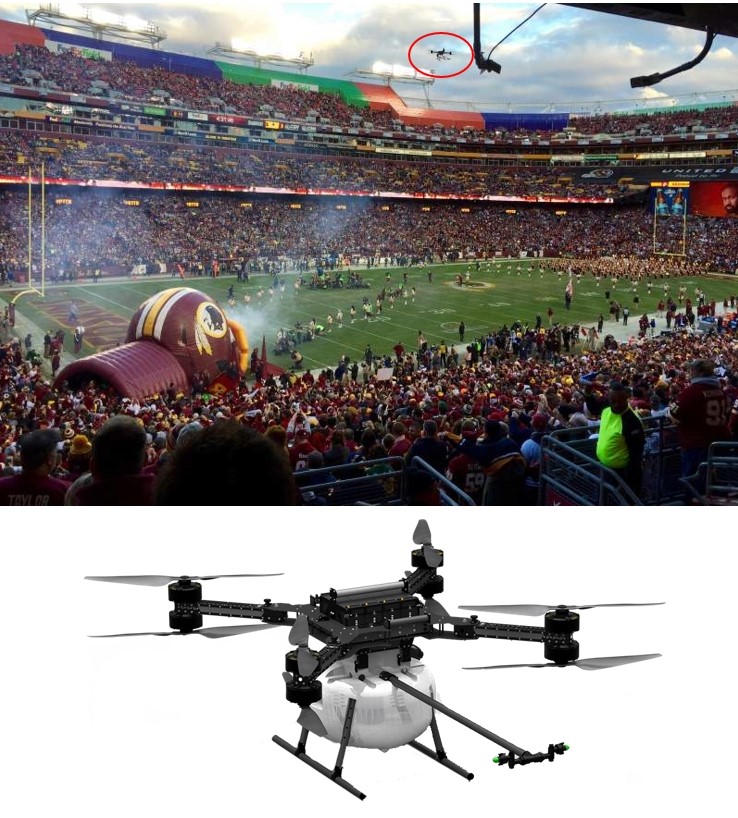
Source: www.aviewfromyseat.com; www.harrisaerial.com/
She noticed something abnormal in the sky over the light stanchions on the northwestern corner of the stadium. Immediately upon spotting the sprayer drone her mind races and she immediately text the photo in Figure 20-11 to her contacts at the Department of Homeland Security.
You are the Agent-In-Charge of this jurisdiction and are called on to immediately assess what, if any actions Counter Unmanned Aviation Systems (CUAS) can technologically, legally and ethically be taken against the drone and its operators.
Legal Considerations
According to the Preventing Emerging Threats Act of 2018, the following authority was granted by congress as follows:
EC. 1602. PROTECTION OF CERTAIN FACILITIES AND ASSETS FROM UNMANNED AIRCRAFT.
(a) In General.—Subtitle A of title II of the Homeland Security Act of 2002 (6 U.S.C. 121 et seq.) is amended by adding at the end the following:
“SEC. 210G. PROTECTION OF CERTAIN FACILITIES AND ASSETS FROM UNMANNED AIRCRAFT.
“(a) Authority.—Notwithstanding section 46502 of title 49, United States Code, or sections 32, 1030, 1367 and chapters 119 and 206 of title 18, United States Code, the Secretary and the Attorney General may, for their respective Departments, take, and may authorize personnel with assigned duties that include the security or protection of people, facilities, or assets, to take such actions as are described in subsection (b)(1) that are necessary to mitigate a credible threat (as defined by the Secretary or the Attorney General, in consultation with the Secretary of Transportation) that an unmanned aircraft system or unmanned aircraft poses to the safety or security of a covered facility or asset.
“(b) Actions Described.—
“(1) IN GENERAL. —The actions authorized in subsection (a) are the following:
“(A) During the operation of the unmanned aircraft system, detect, identify, monitor, and track the unmanned aircraft system or unmanned aircraft, without prior consent, including by means of intercept or other access of a wire communication, an oral communication, or an electronic communication used to control the unmanned aircraft system or unmanned aircraft.
“(B) Warn the operator of the unmanned aircraft system or unmanned aircraft, including by passive or active, and direct or indirect physical, electronic, radio, and electromagnetic means.
“(C) Disrupt control of the unmanned aircraft system or unmanned aircraft, without prior consent, including by disabling the unmanned aircraft system or unmanned aircraft by intercepting, interfering, or causing interference with wire, oral, electronic, or radio communications used to control the unmanned aircraft system or unmanned aircraft.
“(D) Seize or exercise control of the unmanned aircraft system or unmanned aircraft.
“(E) Seize or otherwise confiscate the unmanned aircraft system or unmanned aircraft.
“(F) Use reasonable force, if necessary, to disable, damage, or destroy the unmanned aircraft system or unmanned aircraft. (PROTECTION OF CERTAIN FACILITIES AND ASSETS FROM UNMANNED AIRCRAFT, 2018)
Upon review of this law it seems clear to you that there is adequate authority to engage in some sort of CUAS activity, however numerous legal and ethical considerations still must be addressed. Often referred to as Counter Unmanned Aviation Systems (CUAS) technology, this security service works to protect spaces such as public stadiums and arenas, amusement parks, casinos or airports, where the presence of drones could be illegal, dangerous or even deadly. (sUAS News, 2018)
Decisions & Dilemmas for Student Consideration
- Who is the owner of the aircraft?
If you decide to act against a UAV prior to identifying its owner or function you will be taking a significant risk if it is an authorized but not properly disclosed vehicle.Identifying ownership is critical however delay can be a catastrophic mistake, endangering thousands if not millions from nuclear, chemical or biological attack. Even if the UAV is harmless using some type CUAS which is obvious to the public thereby risking a mass stampede of over 82,000 spectators. - What is its purpose?
Will destroying it because a failure of a critical function related to the game that was mistakenly not disclosed to authorities?If there is a legitimate purpose perhaps assisting in the broadcast by spraying an anti-fogging agent on the overhead television camera suspended on wires above the field. - What is the payload?
If a harmful agent as suggested above will a CUAS actually exacerbate the damage and injury caused by dispersing the agent in the payload before its nature is known. ? - Should the public be advised?
- What will be the consequence of delay in acting?
Conclusions
Although it is impossible to cover all the legal considerations resulting from the growth of autonomous systems, hopefully students will take away a better understanding of the interface of law and technology. The contents of this chapter as well as chapter 2 of the First Edition should serve as a sampling of the techno-legal considerations which will confront all of us as we move forward in a world with increasing automation. Although there are no hard and fast rules to guide students when considering or confronting these issues, what students must take into consideration is what the consequences or each new law, new technology or new application may have from a legal perspective.
Bibliography
49 U.S. Code § 40103, 49 U.S. Code § 40103 Sovereignty and use of airspace (U.S. Code July 5, 1994).
Cornell University Legal Information Institute. (2019, June 5). But-for test. Retrieved from law.cornell.edu: https://www.law.cornell.edu/wex/but-for_test
Cornell University Legal Information Institute. (2019, June 5). Intervening Cause. Retrieved from law.cornell.edu: https://www.law.cornell.edu/wex/intervening_cause
Cornell University Legal Information Institute. (2019, June 5). Personal Jurisdiction. Retrieved from law.cornell.edu: https://www.law.cornell.edu/wex/personal_jurisdiction
Deloitte Center for Government Insights analysis. (2018, June 18). The future of regulation. Principles for regulating emerging technologies. Retrieved from Deloitte Insights: https://www2.deloitte.com/insights/us/en/industry/public-sector/future-of-regulation/regulating-emerging-technology.html
Dewey, D. (2017, July 14). Drone crashes into LDS temple in Utah; raises questions of airspace rules. Retrieved from eastidahonews.com: https://www.eastidahonews.com/2017/07/drone-crashes-lds-temple-utah-raises-questions-airspace-rules/
Diversity of citizenship; amount in controversy; costs, 28 U.S. Code § 1332 (United States Congress June 25, 1948).
DJI. (2019, June 5). DJI Enterprise. Retrieved from Enterprise DJI.com: https://enterprise.dji.com/civil-protection
DLSR Pros. (2019, June 3). Best Drones (UAVs) for Firefighting in 2019. Retrieved from dlsrpros.com: https://www.dslrpros.com/dslrpros-blog/best-drones-firefighting-2019/
European Union. (2019, May 2019). About the regulation and data protection. Retrieved from ec.europa.eu: https://ec.europa.eu/commission/priorities/justice-and-fundamental-rights/data-protection/2018-reform-eu-data-protection-rules_en
Federal Question, 28 U.S. Code § 1331 (United States Congress June 25, 1948).
Guardbaum, S. (1994). The Nature of Preemption. Cornell Law Review, 767, 771.
Harris Aerial. (2019, June 5). Carrier HX8 Sprayer Drone. Retrieved from harrisaerial.com: https://www.harrisaerial.com/carrier-hx8-sprayer/
Jones, T. (2017). International Commercial Drone Regulation and Drone Delivery Services. Santa Monica: The Rand Corporation.
Legal Information Institute – Cornell University. (2019, May 31). Strict Liability . Retrieved from Legal Information Institute: https://www.law.cornell.edu/wex/strict_liability
MacGregor, D. S. (2018). Colorado Causes of Action: Elements, Defenses, Remedies, and Forms. Denver: Bradford Publishing Co. .
Marbury v. Madison, 5 U.S. 137 (United States Supreme Court February 23, 1803).
McCullogh v. Maryland, 17 U.S. 316 (United States Supreme Court March 6, 1819).
Muspratt, A. (2018, November 22). New global drone standards proposed. Retrieved from Defence iQ: https://www.defenceiq.com/defence-technology/news/new-global-drone-standards-proposed
National Conference of State Legislatures. (2018, September 10). Current Unmanned Aircraft State Law Landscape. Retrieved from NCSL.org: http://www.ncsl.org/research/transportation/current-unmanned-aircraft-state-law-landscape.aspx
NBC Today Show. (2018, May 9). How peeping drones could be spying on you without you knowing it. Retrieved from Today.com: https://www.today.com/video/how-peeping-drones-could-be-spying-on-you-without-you-knowing-it-1229001795967
Nichols, R. K. (2018). Unmanned Aircraft Systems (UAS) In the Cyber Domain: Protecting USA’s Advanced Air Assets. 1st Ed. Manhattan, KS: New Prairie Press.
North Carolina Department of Transportation. (2019, May 30). Law & Regulations. Retrieved from NCDOT.GOV: https://www.ncdot.gov/divisions/aviation/uas/Pages/laws-regulations.aspx
O’Sullivan, J. L. (1845). The Great Nation of Futurity. United States Magazine and Democratic Review Vol 6 Issue 23, pp. 426-430.
Porter, J. D. (2019, June 8). jdporterlaw.com/intellectual-property-law/. Retrieved from jdporterlaw.com: http://www.jdporterlaw.com/intellectual-property-law/
Price Waterhouse Coopers, LLP. (2018). Skies without limits – Drones- taking the UK’s economy to new heights. London: Pricewaterhousecoopers, LLP.
PROTECTION OF CERTAIN FACILITIES AND ASSETS FROM UNMANNED AIRCRAFT, H. R. 302 (United States Congress January 3, 2018).
Ricker, D. (2017, July 1). Navigating drone laws has become a growing and lucrative legal niche. Retrieved from ABA Journal: http://www.abajournal.com/magazine/article/drone_law_attorneys
Sanchez, M. (2019, June 4). No Drones. Retrieved from Unspalsh.com: https://unsplash.com/photos/oMqswmrie4Y
Schroeder, A. (2018, February 1). Localizing Humanitarian Drones: Robotics & Disaster Response from the Maldives to Malawi. Retrieved from medium.com: https://medium.com/radiant-earth-insights/localizing-humanitarian-drones-robotics-disaster-response-from-the-maldives-to-malawi-a1f362432cb1
Singer v. City of Newton, 284 F. Supp. 3d 125 (U.S. District Court Massachusetts September 21, 2017).
Sovereignty and use of airspace, 49 U.S. Code § 40103 (United States Congress July 5, 1994).
sUAS News. (2018, March 2). RAS Consulting & Investigations hire Jeff Parisse to offer sophisticated UAS security and surveillance services. Retrieved from suasnews.com: https://www.suasnews.com/2018/03/ras-consulting-investigations-hire-jeff-parisse-offer-sophisticated-uas-security-surveillance-services/
UAV Coach. (2019, May 30). Drone Laws in South Carolina (2019). Retrieved from UAVcoach.com: https://uavcoach.com/drone-laws-south-carolina/
United States Constitution Article VI, Sec.2 (United States of America September 17, 1787).
Wright, T. (2017, August 11). You’ve Been Warned: Keep Your Drones Away From Military Bases. Retrieved from Air & Space, Smithsonian: https://www.airspacemag.com/daily-planet/keep-your-drones-away-military-base-180964451/
- Since popular public locations can be considered “soft targets” for terrorists or criminals it would certainly make sense to limit such overflight to known or approved aircraft with a heavily vetted pedigree of reliability, trustworthiness and piloting skill ↵
- Students should note that this diagram is more of an example than a complete list of agencies, departments and sub bureaucratic creations which all impact the UAS industry on a federal level. ↵
- Others have been reputed to have stated “The best government is that which governs least” including Thomas Jefferson, John Locke and Henry David Thoreau however it appears that O’Sullivan was the first to have penned the generalized concept. ↵
- https://www.today.com/video/how-peeping-drones-could-be-spying-on-you-without-you-knowing-it-1229001795967 ↵
- There may be many other appropriate jurisdictions for litigation involving Randy’s actions in the national park. Injuries to visitors from nearby states or even nations may well have a right to bring claims in other jurisdictions outside Colorado. For the purpose of brevity, we have limited our inquiry to one state. ↵

